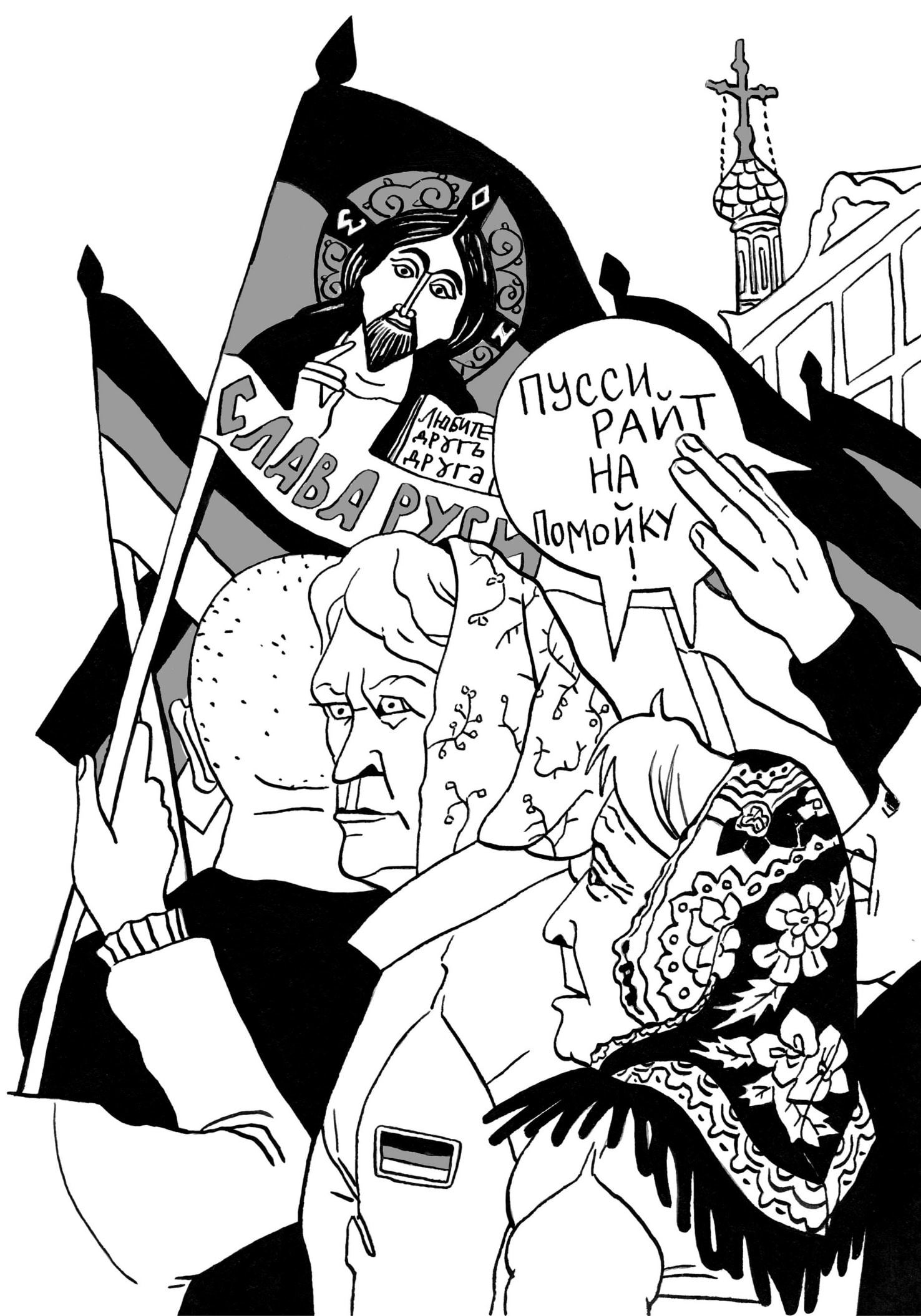26 February 2017 In “Other Russias,” a new collection of graphic reportage by Victoria Lomasko, Russians from radically different walks of life come face to face for the first time. A stonemason and Orthodox activist named Sergei, shown with an icon hanging around his neck, announces, “The West wants to destroy the bold and beautiful Russian people.” On the opposite page sits Victor Mizin, a lecturer in political science at the Moscow State Institute of International Relations. With a shot glass and a half-empty carafe of vodka on the table in front of him, Mizin complains, “Russians are shit. But me, I’m seventh-generation intelligentsia.” In real life, Sergei and Victor would never sit down together for a conversation, and yet, in Lomasko’s view, they are voices that need to be heard together in order to be fully understood.

Victoria Lomasko,Put Pussy Riot in the trash!, illustration.
Lomasko, who grew up in Serpukhov, a town in the Moscow region, has spent nearly a decade documenting the lives of ordinary people in provincial Russian cities, remote villages, and urban underbellies, the kinds of people who rarely make it into the press or the corridors of power, and who have little hope that life will get better. In her book, which is out this month from n+1 Books, we meet children so culturally and geographically isolated that they don’t even know that Moscow is a city, Kazakh migrant workers enslaved by a sadistic Moscow supermarket owner, and sex workers operating out of offices and vans in order to feed their husbands and children. As Americans have recently learned, social invisibility can hide anger that festers until it explodes. In the long-standing tradition of the Russian left, Lomasko “goes to the people,” bringing back the stories of those who would otherwise remain in silence. Though her figures are rendered in broad, black-and-white strokes, Lomasko’s depictions of God-fearing old ladies, young skinheads, and striking truckers never fall into the traps of parody, contempt, or stereotype. Her focus on the daily lives of regular people offers a respite from the international fixation on Vladimir Putin—who is, after all, only one of a hundred and forty-four million Russians.
From an early age, Lomasko was intent on becoming an artist. Though only her father, himself a self-taught artist, supported her plan, she made it to Moscow. There she earned a bachelor’s degree in art, and then attended a fashionable art school where she never felt that she fit in. Her work is suffused with the sympathy of shared experience: in her own way, she, too, operates on the margins. In the post-Soviet art scene, she writes in her book’s introduction, conceptualism and non-figurative art were considered the only options for serious artists. Rejecting the hermetic white box of the gallery, she decided to go rogue, drawing from life. She refused even to draw from photographs; as she puts it, “I felt the need to complete my drawings on the spot, to serve as a conductor for the energy generated by events as they happened.” In a series on Moscow’s 2012 “Marches of Millions,” in which Russians took to the streets in support of fair elections, balaclava-wearing, Pussy Riot-supporting feminists stare down Orthodox babushkas who wave Jesus flags and shout, “Put Pussy Riot in the trash!” It’s a portrait of opposition politics that is also a portrait of deep cultural divisions. Neither Russia’s strengths nor its problems, Lomasko’s book argues, can be attributed to a single force.
“Other Russias” ’s portrayals of women are particularly powerful. In “The Girls of Nizhny Novgorod,” featuring sex workers in a provincial city, Lomasko’s subjects speak frankly about their anger at men: “Some clients ask us to piss on them, but I’d be happy to shit on them, on behalf of all women.” Of a group of sex workers who operate out of a van, Lomasko writes, “They reminded me of pilots, ready at any moment to parachute out of the cockpit. They had the special charisma of people for whom the risk of death has become commonplace.” The series “Feminine” draws on intimate conversations with provincial women. A gnarled woman with a dog sits in front of a barroom table covered in apples and beer cans, saying, “When I was young, I had a date lined up on every corner.” On the next page, walking down the street, she laments, “There are no men in this town, and no factories.” For such women, youth is the only opportunity; hope dies with it.
In the same section of the book, Lomasko reflects on her own position as a Russian woman in her thirties, unmarried and childless. When she returns to her home town, she says, even her divorced friends sympathize with her “bitter plight,” though she is a well-travelled artist and activist with exhibits, friends, and fans around the world. As she puts it, “I became an artist, but I do not feel like a winner.” In an artist’s statement for her drawing series “Unwanted Women,” which will go on display at Brooklyn’s Ortega y Gasset Projects next week, she writes, of her focus on female figures who might otherwise go overlooked, “Why am I interested in them? Because I’m a superfluous woman myself.” And yet Lomasko’s gender has brought her at least one clear advantage, granting her entry to certain realms of Russian life that might otherwise be closed. She describes being allowed to remain at a polling station, watching the ruling party commit election fraud, even after all the other journalists and observers were expelled: “I, the female artist, was allowed to stay on as an amusing oddity.”

